Preparation and Molecular Dynamics Simulation of RDX/MUF Nanocomposite Energetic Microspheres with Reduced Sensitivity
Abstract
:1. Introduction
2. Experiment Parts
2.1. Molecular Dynamics (MD) Simulation
2.2. Materials
2.3. Synthesis
2.4. The Influence of Key Factors on the Morphology of Refined Cyclotrimethylene Trinitramine/Melamine-Urea-Formaldehyde (RDX/MUF)
3. Results and Discussion
3.1. Stability Analysis of RDX/Urea-Formaldehyde Resin Binder (UF)
3.2. Molecular Dynamics (MD) Simulation of Optimal Reaction Temperature
3.3. Morphologies of RDX before and after Coating
3.4. Thermal Properties
3.5. Safety Performance
4. Conclusions
Author Contributions
Funding
Conflicts of Interest
References
- Kumar, R.; Siril, P.F.; Soni, P. Preparation of Nano-RDX by Evaporation Assisted Solvent—Antisolvent Interaction. Propellants Explos. Pyrotech. 2014, 39, 383–389. [Google Scholar] [CrossRef]
- He, B.; Stepanov, V.; Qiu, H.; Krasnoperov, L.N. Production and Characterization of Composite Nano-RDX by RESS Co-Precipitation. Propellants Explos. Pyrotech. 2015, 40, 659–664. [Google Scholar] [CrossRef]
- Padfield, J.; Ferran, M.D.; Linmei, A.L. Chemical Desensitization of Explosives. Part 1. Effect of Ethyl Centralite on the Properties of an RDX-Based PBX. J. Energ. Mater. 2014, 32, 106–116. [Google Scholar] [CrossRef]
- Liu, J.; Bao, X.Z.; Rong, Y.B.; Hao, G.Z.; Xiao, L.; Gao, H.; Ke, X.; Chen, T.; Jiang, W.; Li, F.S. Preparation of nano-RDX-based PBX and its thermal decomposition properties. J. Therm. Anal. Calorim. 2017, 131, 2693–2698. [Google Scholar] [CrossRef]
- Wang, Y.; Li, X.; Chen, S.; Ma, X.; Yu, Z.; Jin, S.; Li, L.; Chen, Y. Preparation and Characterization of Cyclotrimethylenetrinitramine (RDX) with Reduced Sensitivity. Materials 2017, 10, 974. [Google Scholar] [CrossRef]
- Shi, X.F.; Li, X.-D.; Wang, J.Y.; Ji, W. Preparation and thermal properties of RDX based ultrafine spherical coated particles. J. Solid Rocket Technol. 2015, 38, 383–386. [Google Scholar]
- Wang, S.; An, C.; Wang, J.; Ye, B. Reduce the Sensitivity of CL-20 by Improving Thermal Conductivity Through Carbon Nanomaterials. Nanoscale Res. Lett. 2018, 13, 85–92. [Google Scholar] [CrossRef]
- Hamedi, G.H. Effects of Polymeric Coating the Aggregate Surface on Reducing Moisture Sensitivity of Asphalt Mixtures. Int. J. Civ. Eng. 2017, 16, 1097–1107. [Google Scholar] [CrossRef]
- Guo, L.; Yang, Z.; Li, Y.; Zu, B.; Dou, X. Sensitive, real-time and anti-interfering detection of nitro-explosive vapors realized by ZnO/rGO core/shell micro-Schottky junction. Sens. Actuators B Chem. 2017, 239, 286–294. [Google Scholar] [CrossRef]
- Lindskog, C.; Asplund, A.; Engkvist, M.; Uhlen, M.; Korsgren, O.; Ponten, F. Antibody-based proteomics for discovery and exploration of proteins expressed in pancreatic islets. Discov. Med. 2010, 9, 565–578. [Google Scholar]
- Gao, Q.; Shi, S.Q.; Zhang, S.; Li, J.; Wang, X.; Ding, W.; Liang, K.; Wang, J. Soybean meal-based adhesive enhanced by MUF resin. J. Appl. Polym. Sci. 2012, 125, 3676–3681. [Google Scholar] [CrossRef]
- Yang, Z.; Ding, L.; Wu, P.; Liu, Y.; Nie, F.; Huang, F. Fabrication of RDX, HMX and CL-20 based microcapsules via in situ polymerization of melamine–formaldehyde resins with reduced sensitivity. Chem. Eng. J. 2015, 268, 60–66. [Google Scholar] [CrossRef]
- Fu, Y.Z.; Liu, Y.Q.; Lan, Y.H. Molecular Dynamics Simulation on Compatibility of Hydroxyl-Terminated Polybutadiene/Plasticizer Blends. Acta Phys. Chim. Sin. 2009, 25, 1267–1272. [Google Scholar]
- Jia, X.; Wang, J.; Hou, C.; Tan, Y. Green Preparation, SpHeroidal, and Superior Property of Nano-1, 3, 5, 7-Tetranittro-1, 3, 5, 7-Tetrazocane. J. Nanomater. 2018, 2018, 5839037. [Google Scholar] [CrossRef]
- No, B.Y.; Kim, M.G. Syntheses and properties of low-level melamine-modified urea-melamine-formaldehyde resins. J. Appl. Polym. Sci. 2010, 93, 2559–2569. [Google Scholar] [CrossRef]
- Cao, X.X.; Zhang, Y.H.; Gu, J.; Tan, H. Study on the Curing Characteristics and Synthesis Process of Modified Urea-formaldehyde Resin with Low Formaldehyde Release. China For. Prod. Ind. 2017, 44, 20–24. [Google Scholar]
- Tohmura, S.; Inoue, A.; Sahari, S.H. Influence of the melamine content in melamine-urea-formaldehyde resins on formaldehyde emission and cured resin structure. J. Wood Sci. 2001, 47, 451–457. [Google Scholar] [CrossRef]
- Lan, Y.; Zhai, J.; Li, D.; Yang, R. Multiscale Simulation on the Influence of Dimethyl Hydantoin on Mechanical Properties of GAP/RDX Propellants. Propellants Explos. Pyrotech. 2014, 39, 18–23. [Google Scholar] [CrossRef]
- Xiao, J.; Fang, G.; Ji, G.; Xiao, H. Simulation investigations in the binding energy and mechanical properties of HMX-based polymer-bonded explosives. Chin. Sci. Bull. 2005, 50, 21–26. [Google Scholar] [CrossRef]
- Hou, C.; Jia, X.; Wang, J. Efficient Preparation and Performance Characterization of the HMX/F2602 MicrospHeres by One-Step Granulation Process. J. Nanomater. 2017, 2017, 3607383. [Google Scholar] [CrossRef]
- Wang, Y.; Song, X.; Song, D.; Liang, L.; An, C.; Wang, J. Synthesis, thermolysis, and sensitivities of HMX/NC energetic nanocomposites. J. Hazard. Mater. 2016, 312, 73–83. [Google Scholar] [CrossRef] [PubMed]
- Xiao, J.; Huang, H.; Li, J.; Zhang, H.; Zhu, W.; Xiao, H. Computation of interface interactions and mechanical properties of HMX-based PBX with Estane 5703 from atomic simulation. J. Mater. Sci. 2008, 43, 5685–5691. [Google Scholar] [CrossRef]
- Barua, A.; Kim, S.; Horie, Y.; Zhou, M. Ignition criterion for heterogeneous energetic materials based on hotspot size-temperature threshold. J. Appl. Phys. 2013, 113, 5794–5799. [Google Scholar] [CrossRef]
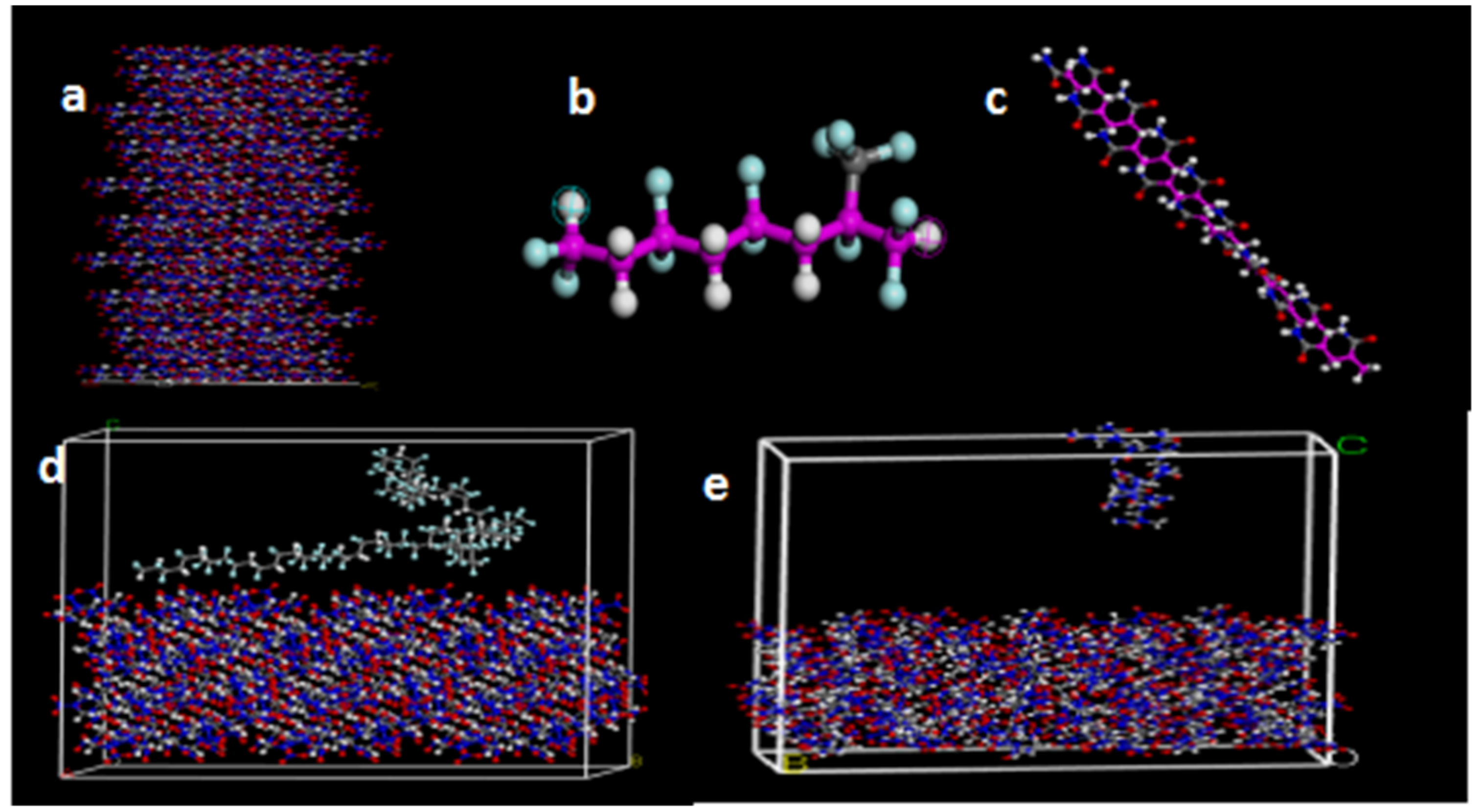
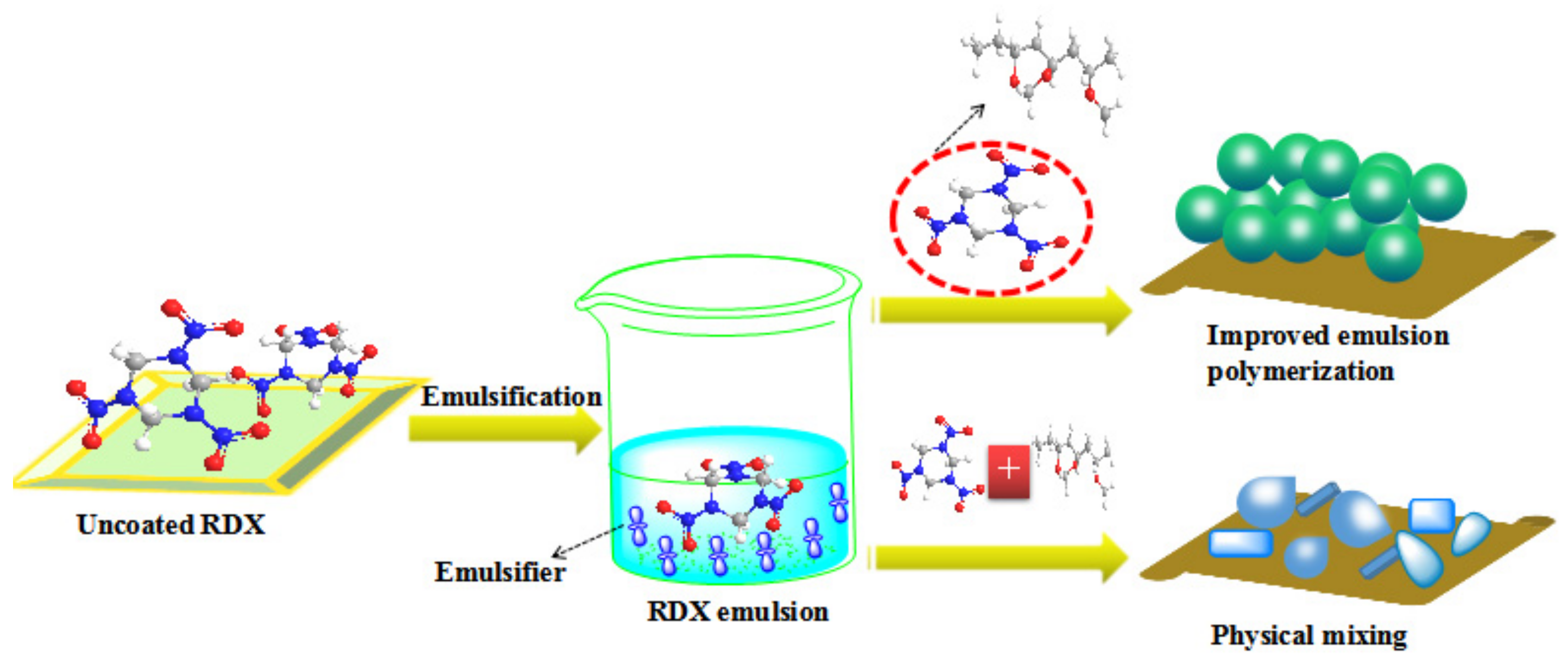
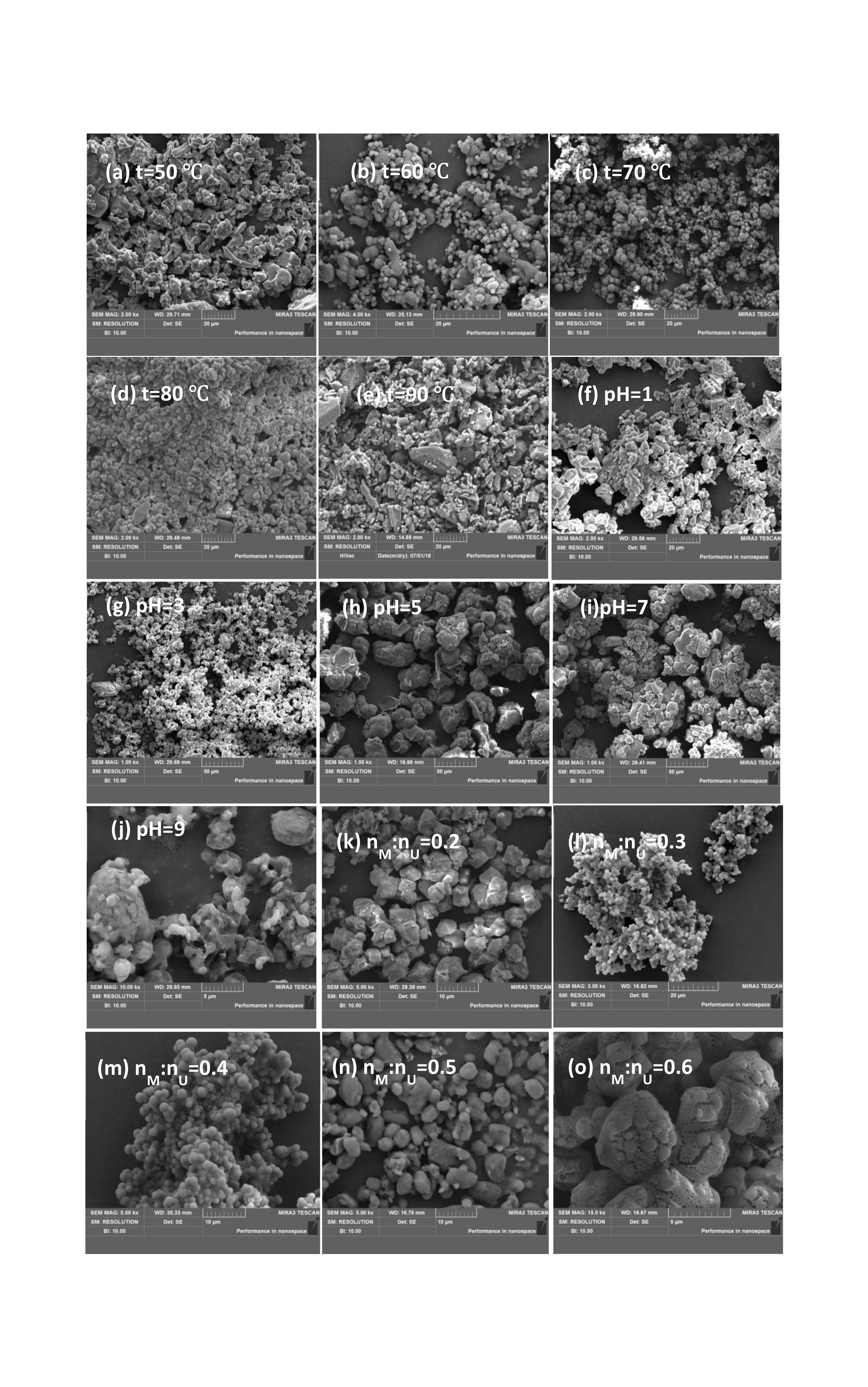
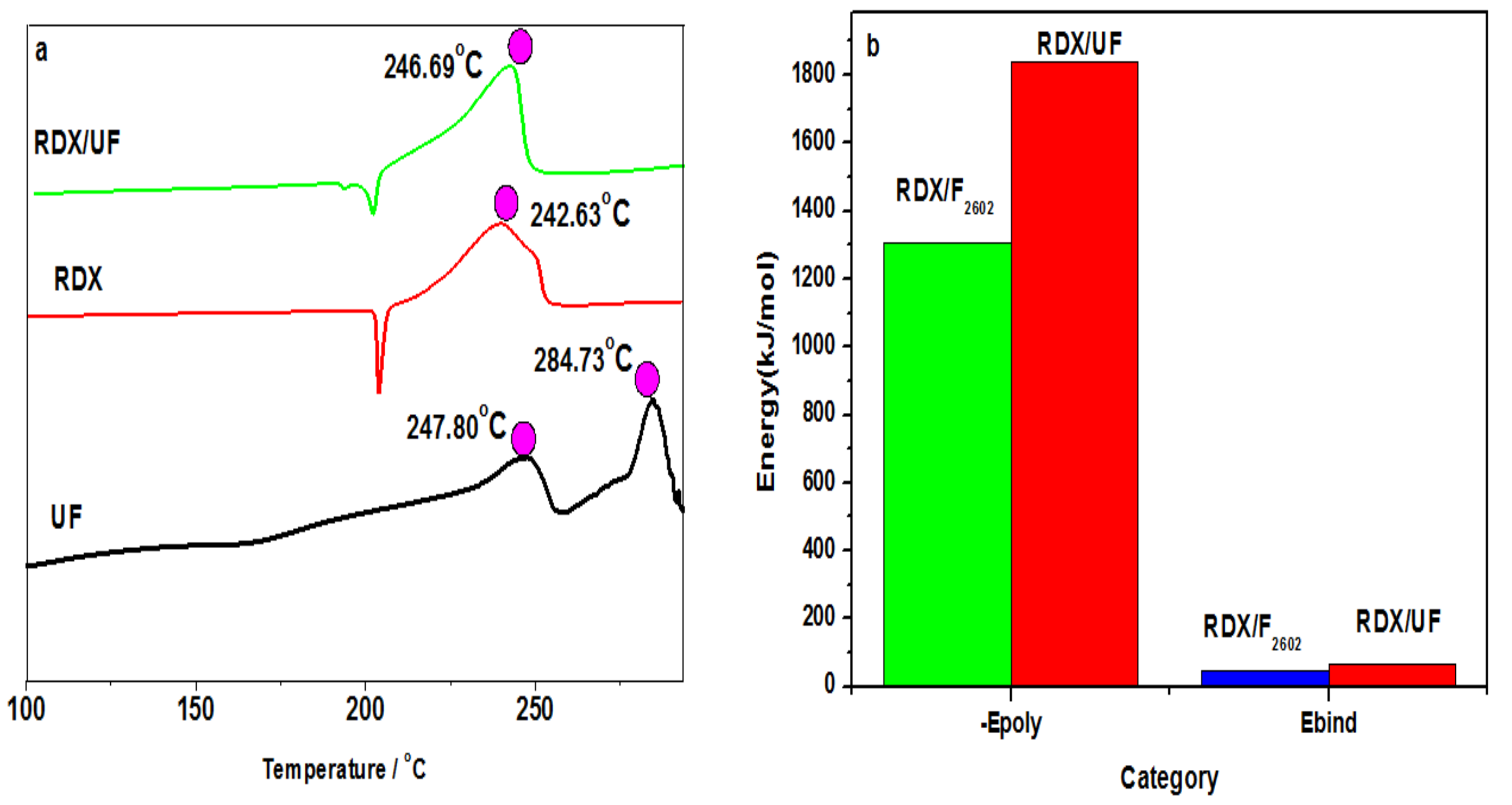
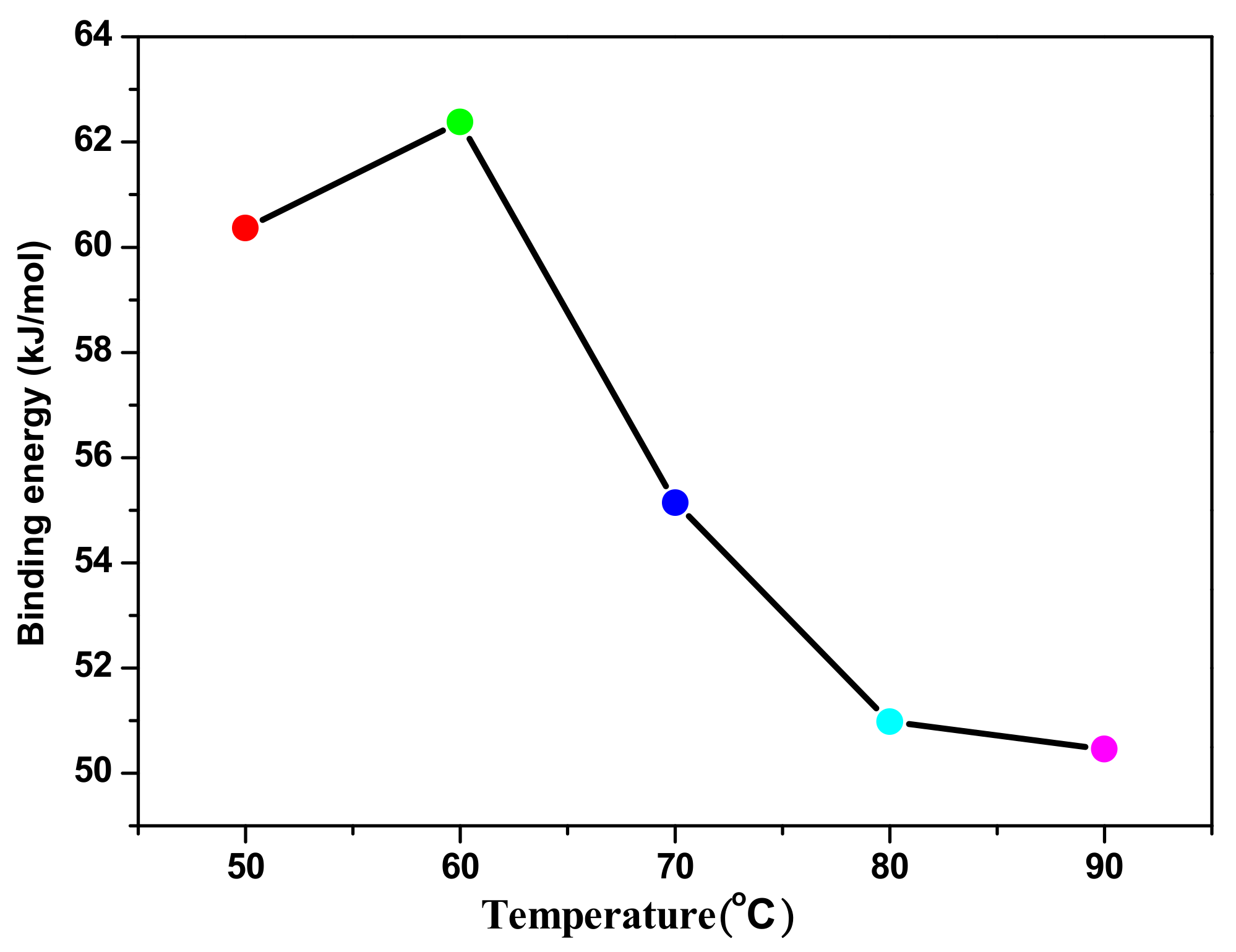
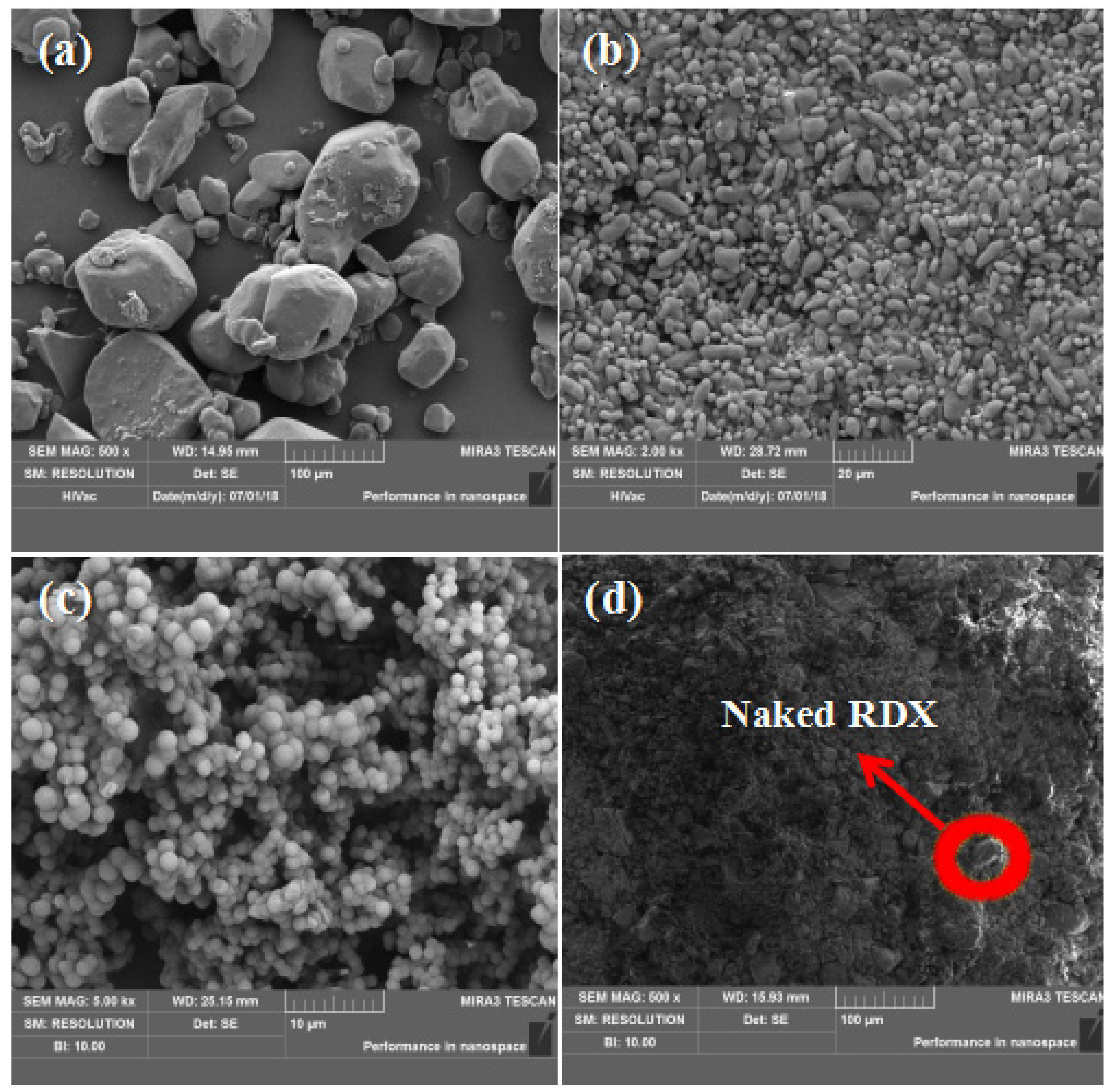
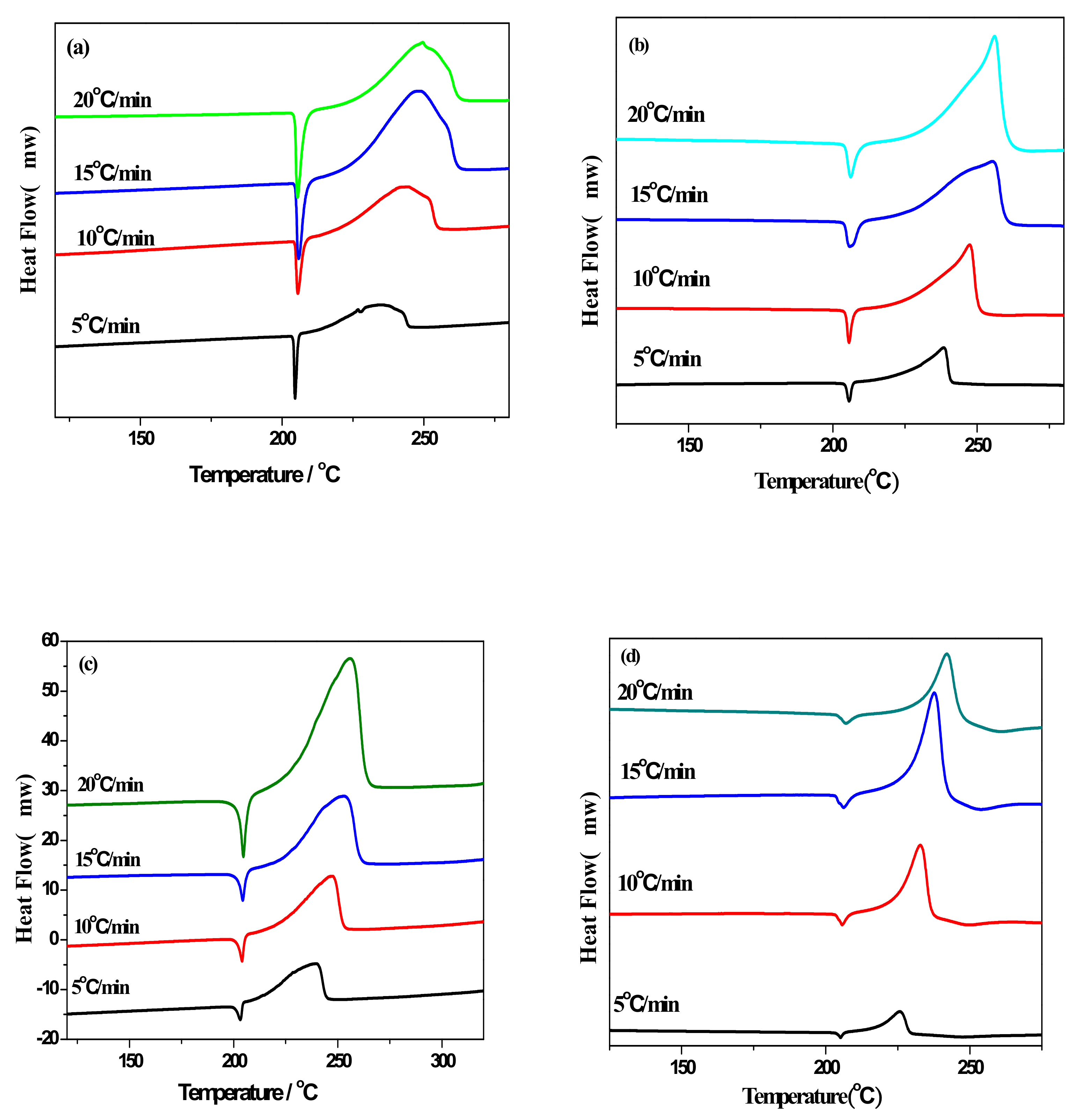
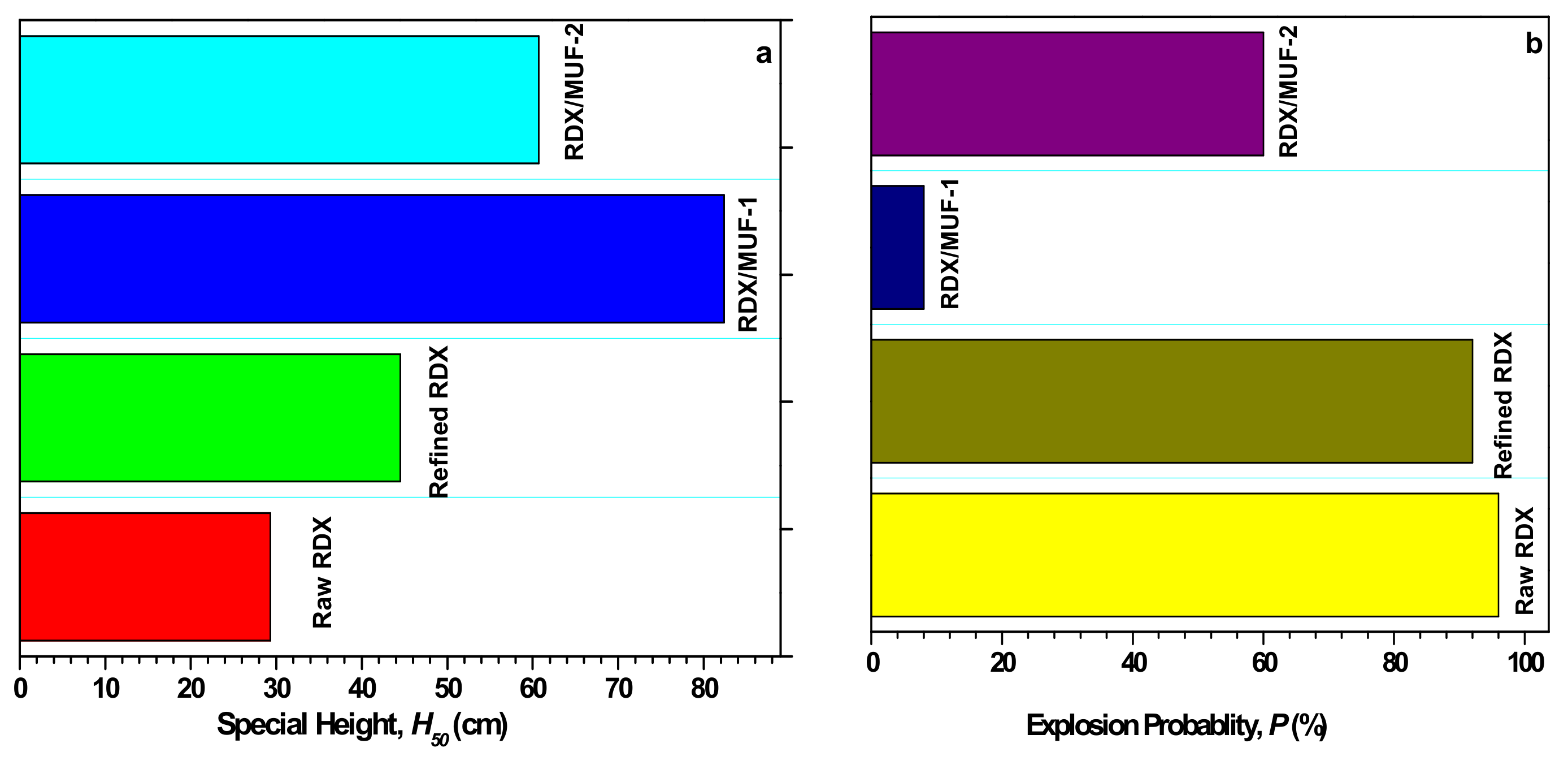
| Parameters | Value | Parameters | Value |
|---|---|---|---|
| Ensemble | Network Virtual Terminal | Force field | COMPASS |
| Temperature | 298 K | Thermostat | Andersen |
| Time | 300 ps | Time step | 1 fs |
| Frame output every | 5000 steps | Cut-off distance | 15.5 Å |
| Spline width | 1 Å | Buffer width | 0.5 Å |
| Samples | Kinetic Factor | Thermal Stability | ||||||
|---|---|---|---|---|---|---|---|---|
| Ea1 | Ea2 | Ea3 | Ea | lgA | R | Tp0/°C | Tb/°C | |
| Raw RDX | 176.23 | 184.83 | 177.09 | 179.38 | 14.65 | 0.98 | 220.58 | 231.04 |
| Refined RDX | 163.53 | 172.18 | 164.39 | 166.70 | 13.27 | 1 | 225.46 | 228.09 |
| RDX/MUF-1 | 205.88 | 186.16 | 178.37 | 190.13 | 14.78 | 0.99 | 228.52 | 231.02 |
| RDX/MUF-2 | 174.98 | 183.40 | 175.82 | 178.07 | 14.96 | 1 | 215.47 | 217.72 |
© 2019 by the authors. Licensee MDPI, Basel, Switzerland. This article is an open access article distributed under the terms and conditions of the Creative Commons Attribution (CC BY) license (http://creativecommons.org/licenses/by/4.0/).
Share and Cite
Jia, X.; Hu, Y.; Xu, L.; Liu, X.; Ma, Y.; Fu, M.; Wang, J.; Xu, J. Preparation and Molecular Dynamics Simulation of RDX/MUF Nanocomposite Energetic Microspheres with Reduced Sensitivity. Processes 2019, 7, 692. https://doi.org/10.3390/pr7100692
Jia X, Hu Y, Xu L, Liu X, Ma Y, Fu M, Wang J, Xu J. Preparation and Molecular Dynamics Simulation of RDX/MUF Nanocomposite Energetic Microspheres with Reduced Sensitivity. Processes. 2019; 7(10):692. https://doi.org/10.3390/pr7100692
Chicago/Turabian StyleJia, Xinlei, Yingying Hu, Lanjuan Xu, Xuewen Liu, Youying Ma, Mingming Fu, Jingyu Wang, and Jing Xu. 2019. "Preparation and Molecular Dynamics Simulation of RDX/MUF Nanocomposite Energetic Microspheres with Reduced Sensitivity" Processes 7, no. 10: 692. https://doi.org/10.3390/pr7100692
APA StyleJia, X., Hu, Y., Xu, L., Liu, X., Ma, Y., Fu, M., Wang, J., & Xu, J. (2019). Preparation and Molecular Dynamics Simulation of RDX/MUF Nanocomposite Energetic Microspheres with Reduced Sensitivity. Processes, 7(10), 692. https://doi.org/10.3390/pr7100692




